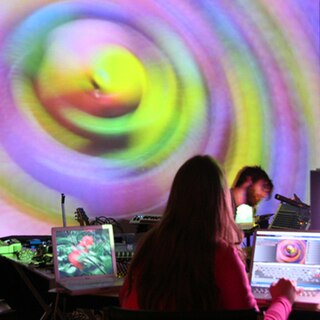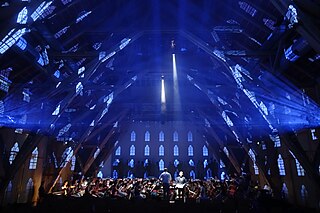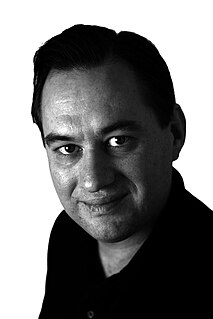
A planetarium is a theatre built primarily for presenting educational and entertaining shows about astronomy and the night sky, or for training in celestial navigation.
A title sequence is the method by which films or television programmes present their title and key production and cast members, utilizing conceptual visuals and sound. It typically includes the text of the opening credits, and helps establish the setting and tone of the program. It may consist of live action, animation, music, still images, and/or graphics. In some films, the title sequence is preceded by a cold open.

The Clark Planetarium is a planetarium and museum situated within The Gateway at the intersection of 400 West and 100 South in downtown Salt Lake City, Utah, United States. The Clark Planetarium opened in April 2003, replacing the historic Hansen Planetarium under a grant from the Clark Foundation in cooperation with Salt Lake County.

Space music, also called spacemusic or space ambient, is a subgenre of new-age music and is described as "tranquil, hypnotic and moving". It is derived from ambient music and is associated with lounge music, easy listening, and elevator music.
Jordan Belson was an American artist and abstract cinematic filmmaker who created nonobjective, often spiritually oriented, abstract films spanning six decades.

VJing is a broad designation for realtime visual performance. Characteristics of VJing are the creation or manipulation of imagery in realtime through technological mediation and for an audience, in synchronization to music. VJing often takes place at events such as concerts, nightclubs, music festivals and sometimes in combination with other performative arts. This results in a live multimedia performance that can include music, actors and dancers. The term VJing became popular in its association with MTV's Video Jockey but its origins date back to the New York club scene of the 70s. In both situations VJing is the manipulation or selection of visuals, the same way DJing is a selection and manipulation of audio.

The Rose Center for Earth and Space is a part of the American Museum of Natural History in New York City. The Center's complete name is The Frederick Phineas and Sandra Priest Rose Center for Earth and Space. The main entrance is located on the northern side of the museum on 81st Street near Central Park West in Manhattan's Upper West Side. Completed in 2000, it includes the new Hayden Planetarium, the original of which was opened in 1935 and closed in 1997. Neil deGrasse Tyson is its first and, to date, only director.
Fulldome refers to immersive dome-based video display environments. The dome, horizontal or tilted, is filled with real-time (interactive) or pre-rendered (linear) computer animations, live capture images, or composited environments.

WorldWide Telescope (WWT) is an open-source set of applications, data and cloud services, originally created by Microsoft Research but now an open source project hosted on GitHub. The .NET Foundation holds the copyright and the project is managed by the American Astronomical Society and has been supported by grants from the Moore Foundation and National Science Foundation. WWT displays astronomical, earth and planetary data allowing visual navigation through the 3-dimensional (3D) Universe. Users are able to navigate the sky by panning and zooming, or explore the 3D universe from the surface of Earth to past the Cosmic microwave background (CMB), viewing both visual imagery and scientific data about that area and the objects in it. Data is curated from hundreds of different data sources, but its open data nature allows users to explore any third party data that conforms to a WWT supported format. With the rich source of multi-spectral all-sky images it is possible to view the sky in many wavelengths of light. The software utilizes Microsoft's Visual Experience Engine technologies to function. WWT can also be used to visualize arbitrary or abstract data sets and time series data.

Video design or projection design is a creative field of stagecraft. It is concerned with the creation and integration of film, motion graphics and live camera feed into the fields of theatre, opera, dance, fashion shows, concerts and other live events. Video design has only recently gained recognition as a separate creative field. For instance, United Scenic Artists' Local 829, the union that represents designers and scenic artists in the US entertainment industry, only added the Projection Designer membership category in 2007. Prior to this, the responsibilities of video design would often be taken on by a scenic designer or lighting designer. A person who practices the art of video design is often known as a Video Designer. However, naming conventions vary around the world, and so practitioners may also be credited as Projection Designer, "Media Designer", Cinematographer or Video Director. As a relatively new field of stagecraft, practitioners create their own definitions, rules and techniques.
A motion comic is a form of animation combining elements of print comic books and animation. Individual panels are expanded into a full shot while sound effects, voice acting, and animation are added to the original artwork. Text boxes, speech bubbles and the onomatopoeia are typically removed to feature more of the original artwork being animated. Motion comics are often released as short serials covering a story arc of a long running series or animating a single release of a graphic novel. Single release issues of a story arc are converted into ten- to twenty-minute-long episodes depending on content.
Semiconductor is UK artist duo Ruth Jarman and Joe Gerhardt. They have been working together for over twenty years producing visually and intellectually engaging moving image works which explore the material nature of our world and how we experience it through the lens of science and technology, questioning how these devices mediate our experiences. Their unique approach has won them many awards, commissions and prestigious fellowships including; SónarPLANTA 2016 commission, Collide @ CERN Ars Electronica Award 2015, Jerwood Open Forest 2015 and Samsung Art + Prize 2012. Exhibitions and screenings include; The Universe and Art, Mori Art Museum, Tokyo, Japan, 2016; Infosphere, ZKM, Karlsruhe, 2016; Quantum of Disorder, Museum Haus Konstruktiv, Zurich, 2015; Da Vinci: Shaping the Future, ArtScience Museum, Singapore, 2014; Let There Be Light, House of Electronic Arts, Basel 2013 ; Field Conditions, San Francisco Museum of Modern Art, 2012; International Film Festival Rotterdam, 2012; New York Film Festival: Views from the Avant Garde, 2012; European Media Art Festival, 2012; Worlds in the Making, FACT, Liverpool 2011 ; Earth; Art of a Changing World, Royal Academy of Arts, London, 2009 and Sundance Film Festival, 2009.
The history of computer animation began as early as the 1940s and 1950s, when people began to experiment with computer graphics – most notably by John Whitney. It was only by the early 1960s when digital computers had become widely established, that new avenues for innovative computer graphics blossomed. Initially, uses were mainly for scientific, engineering and other research purposes, but artistic experimentation began to make its appearance by the mid-1960s – most notably by Dr Thomas Calvert. By the mid-1970s, many such efforts were beginning to enter into public media. Much computer graphics at this time involved 2-dimensional imagery, though increasingly as computer power improved, efforts to achieve 3-dimensional realism became the emphasis. By the late 1980s, photo-realistic 3D was beginning to appear in film movies, and by mid-1990s had developed to the point where 3D animation could be used for entire feature film production.

Computer-generated imagery (CGI) is the application of computer graphics to create or contribute to images in art, printed media, video games, simulators, computer animation and VFX in films, television programs, shorts, commercials, and videos. The images may be dynamic or static, and may be two-dimensional (2D), although the term "CGI" is most commonly used to refer to the 3-D computer graphics used for creating characters, scenes and special effects in films and television, which is described as "CGI animation".

V. Owen Bush is a Canadian designer, producer, and filmmaker who uses immersion and participation to create transformative social experiences. His works have been seen worldwide in venues such as digital planetariums, live concerts and events, IMAX 3D, broadcast television, mobile devices, and the web.
Where in the Universe Is Carmen Sandiego? was a live theatrical, edutainment program including a planetarium film, that is now licensed to planetariums across the US, Canada, and Japan. Started in 1999, the show featured the effects work of Adrian Ropp, produced by Dr. William A. Gutsch and composed by Mark Mercury. The program was "modeled quite closely after the very successful television [TV] programs, Where in the World Is Carmen Sandiego? and Where in Time Is Carmen Sandiego?. There was a conscious decision to design it as a "fast paced 'quiz show in outer space' but fashioned to foster and hone listening and math skills rather than requiring the audience to quickly recall pre-learned trivia". The program also encouraged audience participation, by answering questions to score points. Where in the Universe is Carmen Sandiego? - II was later created, and included "over 30 minutes of original 3-D character and astronomical special effects animation". Both shows were written, produced, and directed by the author under license from Broderbund Software, Inc. Both programs utilize a model which "interfac[ed] a live teacher / presenter and the audience with famous characters recognized by children in a highly interactive setting. The Carmen products' goal was to "create even higher end products by utilizing large amounts of 3-D color computer animation yet, at the same time, make the shows affordable to as many planetariums as possible".
Takeshi Murata is an American contemporary artist who creates digital media artworks using video and computer animation techniques. In 2007 he had a solo exhibition, Black Box: Takeshi Murata, at the Hirshhorn Museum and Sculpture Garden in Washington, D.C. His 2006 work "Pink Dot" is in the Hirshhorn's permanent collection, and his 2005 work "Monster Movie" is in the permanent collection of the Smithsonian American Art Museum. His 2013 short film "OM Rider" was selected to screen as an animated short film at the 2015 Sundance Film Festival.
Victor Acevedo is an American artist best known for his digital work involving printmaking and photography. He was introduced to computer graphics while attending Gene Youngblood's survey class (based on his book Expanded Cinema) at Art Center College of Design in Pasadena, California.